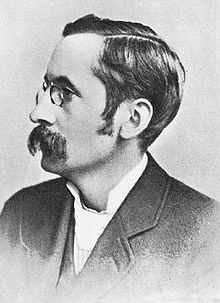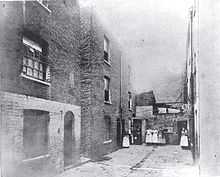Boundary Estate
Coordinates: 51°31′33″N 0°04′29″W / 51.5259°N 0.0748°W
The Boundary Estate is a housing development, formally opened in 1900, in the East End of London, England. It is situated in the north western corner of Bethnal Green in the London Borough of Tower Hamlets and on the boundary with Shoreditch, in the London Borough of Hackney.
The estate, constructed from 1890, was one of the earliest social housing schemes built by a local government authority. It replaced the Friars Mount slum[1] in the Old Nichol and was begun by the Metropolitan Board of Works and completed by the recently formed London County Council. It is, arguably, the world's first council housing. The demolition rubble was used to construct a mound in the middle of Arnold Circus at the centre of the development, housing an extant bandstand. The estate consists of multi-story brick tenements radiating from the central circus, each of which bears the name of a location along the River Thames.
History
Old Nichol Rookery

In 1680 John Nichol of Gray's Inn, who had built seven houses here, leased 4.75 acres (19,200 m2) of gardens for 180 years to a London mason, Jon Richardson, with permission to dig for bricks. The land became built up piecemeal with houses, built by a number of sub-lessees. Many of the streets were named after Nichol, and by 1827 the 5-acre (20,000 m2) estate consisted of 237 houses.[2]
Henry Mayhew visited Bethnal Green in 1850, and noted for the Morning Chronicle the trades in the area: tailors, costermongers, shoemakers, dustmen, sawyers, carpenters, cabinet makers and silkweavers. In the area, it was noted:
roads were unmade, often mere alleys, houses small and without foundations, subdivided and often around unpaved courts. An almost total lack of drainage and sewerage was made worse by the ponds formed by the excavation of brickearth. Pigs and cows in back yards, noxious trades like boiling tripe, melting tallow, or preparing cat's meat, and slaughter houses, dustheaps, and 'lakes of putrefying night soil' added to the filth.[3]
The vicar of St. Philip's, the church serving the Nichol, quoted by Frederick Engels, in 1844 had found that conditions were far worse than in a northern industrial parish, that population density was 8.6 people to a (small) house, and that there were 1,400 houses in an area less than 400 yards (370 m) square;[4] and in 1861 John Hollingshead, of the Morning Post, in his Ragged London noted that the Nichol had grown even more squalid in the last 20 years as old houses decayed and traditional trades became masks for thieves and prostitutes. The Builder in 1863, noted the numbers inhabiting unfit cellars, the lack of sanitation and that running water was only available for 10–12 minutes each day (excepting Sundays!).[5]
Demand for change

The clearance of the Old Nichol Street Rookery, as it was notoriously known, was the result of an energetic campaign by the local incumbent, Reverend Osborne Jay of Holy Trinity,[6] who arrived in the parish in December 1886. Charles Booth had already noted the extreme poverty in the area in his study of London poverty.[7] Nearly 6,000 individuals were crammed into the packed streets. The death rate was twice that of the rest of Bethnal Green, and four times that of London. One child in four died before his or her first birthday. Jay persuaded Arthur Morrison to visit the area, and the result was the influential A Child of the Jago, a barely fictionalised account of the life of a child in the slum, re-christened by Morrison as "The Jago": 'What was too vile for Kate Street, Seven Dials, and Ratcliffe Highway in its worst day, what was too useless, incapable and corrupt - all that teemed on the Old Jago'. Demolition actually began before the publication of the book.
Such was the success of the campaign, that the Prince of Wales (Bertie) officially opened the estate in 1900, saying Few indeed will forget this site who had read Mr Morrison's A Child of the Jago.
While the new flats replaced the existing slums, where many had lived below street level and in appalling conditions, with decent accommodation for the same number of people, it wasn't the same group of people. The original inhabitants were forced further to the East, creating new overcrowding and new slums in areas such as Dalston and Bethnal Green. At this time, no help was available to find new accommodation for the displaced, and this added to the suffering and misery of many of the former residents of the slum.
The impresarios and brothers Lew Grade and Bernard Delfont (born Winogradsky) moved to the Boundary Estate in 1914, from nearby Brick Lane and attended Rochelle Street School.[8] At that time, 90% of children attending the school spoke Yiddish.
Today

The flats remain and are Grade II listed,[9][10] together with the bandstand.[11] In their day, they were revolutionary in their provision of facilities for residents. Today, despite the lack of some modern amenities they remain popular with tenants and there is an active community. The Rochelle School is now a community arts centre.
Tower Hamlets Council has made proposals to transfer the estate to a housing association,[12] and upgrade the accommodation. A full refurbishment of one of the blocks, Iffley House was carry out by Sprunt Architects to demonstrate how this might be achieved but the proposal was rejected by a ballot of tenants in November 2006.
The estate radiates from a centrepiece roundabout, Arnold Circus, formed around a garden with a bandstand. It is now being preserved by the Friends of Arnold Circus and has received grants for regeneration. Restoration work on the bandstand was completed in 2010.
Arnold Circus is also a mark point on several ley alignments including Alfred Watkins' "Strand Ley"[13] and "The Coronation Line".[14]
One of the roads that link into the circus is the northern end of Club Row, a part of Brick Lane market, well known as an animal market until this activity was closed down in 1983.[15]
Transport
The nearest London Underground stations are Liverpool Street and Old Street. The nearest London Overground station, Shoreditch High Street railway station, opened on 4 April 2010.
References
- ↑ Taylor, R., Walks Through History: Exploring the East End, (2001)
- ↑ 'Bethnal Green: The West: Shoreditch Side, Spitalfields, and the Nichol', A History of the County of Middlesex: Volume 11: Stepney, Bethnal Green (1998), pp. 103-09 accessed: 14 November 2006.
- ↑ 'Bethnal Green: Building and Social Conditions from 1837 to 1875', A History of the County of Middlesex: Volume 11: Stepney, Bethnal Green (1998), pp. 120-26 accessed: 14 November 2006.
- ↑ Engels, The Condition of the Working Class in England, 35-6.
- ↑ The Builder, vol. XXI 1082 (October 31st, 1863) accessed 8 Feb 2007
- ↑ The London, 12 March 1896 To Check the Survival of the Unfit accessed 13 November 2006
- ↑ Charles Booth "Life and Labour of the People in London" (London: Macmillan, 1902-1903) at The Charles Booth on-line archive accessed 10 Nov 2006
- ↑ 'Bethnal Green: Building and Social Conditions from 1876 to 1914', A History of the County of Middlesex: Volume 11: Stepney, Bethnal Green (1998), pp. 126-32 accessed: 14 November 2006.
- ↑ Historic England. "Details from image database (205719 )". Images of England. Retrieved 8 August 2009.
- ↑ Historic England. "Details from image database (205720 )". Images of England. Retrieved 8 August 2009.
- ↑ Historic England. "Details from image database (205717 )". Images of England. Retrieved 8 August 2009.
- ↑ Battle of the Boundary, The Guardian, 21 June 2006
- ↑ Alfred Watkins The Old Straight Track (Abacus, 1994) ISBN 0-349-13707-2
- ↑ Chris Street Earthstars: The Visionary Landscape (Hermitage Publishing, 2001) ISBN 0-9515967-1-3
- ↑ "The death of Club Row animal market". eastlondonhistory.com. 14 June 2011. Retrieved 12 August 2012.
Further reading
- Rosemary Taylor - Walks Through History – Exploring the East End (Breedon Books, 2001)
- Sarah Wise - The Blackest Streets: The Life and Death of a Victorian Slum (Bodley Head, 2008)